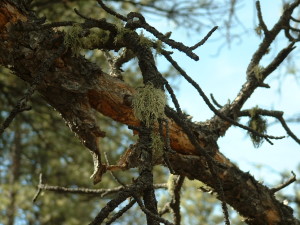Usnea is a lichen that I’ve taken quite a liking to. Although prolific in Teller & Park County it is a slow growing, long lived lichen. Grayish green to yellow green in color, it grows on trees throughout the World. It even grows on trees that have long since expired. The whole lichen may be harvested at any time of the year. It ranges in size from small tufts to long hanging strands resembling hair hence the common name “Old Man’s Beard”. It may be gray green in the smaller tufts and somewhat yellow green in the longer strands that grow in the old growth forests. The usnea that grows in our area is pictured above. It generally prefers conifers such as Pine, Spruce, Juniper and Firs although I have seen it growing on Aspen and also grows on deciduous hardwoods. It grows in nearly every forest and orchard and you will find it if you are looking for it. Occasionally, the wind or a squirrel will dislodge it from the tree and you will find tufts of it on the ground. Once you have made a ground find, just look up. Chances are you are standing next to a tree that will provide you with more than enough of this wonderful medicine. While usnea is prolific in some areas, in others like its main habitat; old growth forests, it is endangered due to logging and development. Being very sensitive to pollution and climate change it should only be harvested for personal use and always away from the road or polluted areas. Although I will confess, if you’ve ever seen anyone picking the green stuff off of freshly cut logs at the lumberyard, that was me and I find this to be an acceptable practice since they will be subjected to the bark stripper apparatus at any moment. I leap into action and fill my pockets going back for seconds. To most people this may seem bizarre behavior. From an herbalist’s point of view, the very act of stripping valuable medicine from a tree with no intention of using it is bizarre indeed.
As a lichen this plant is actually composed of two plants intertwined. The inner part of the plant (the cortex) is a thin white thread that stretches when wet. The outer part (the sheath) is what gives the herb its color and grows around the thin white cortex and provides photosynthesis for the symbiotic organism. The distinctive method of identifying Usnea is to wet it and see if it stretches like a rubber band. Although plants are extremely complex in their chemical makeup and will probably never be fully understood by man, they are potently synergistic in their chemical actions. Usnea’s main chemical constituent; usnic acid is highly antibacterial making it a significant herb in treating resistant bacteria. Specifically Gram positive resistant bacteria. I find it very useful in the case of re-occurring strep throat, although it is used for many different bacterial infections. Traditionally used throughout the world for skin infections, abscesses, upper respiratory and lung infections, vaginal infections, and fungal infections. An older method of treating large gaping wounds of the body is to soak the lichen in garlic juice or a strong garlic decoction and pack the wound. This method provides antibacterial, anti-inflammatory, antiseptic, astringent, analgesic, and wound healing actions directly inside the wound. It can also be used for abscesses in veterinary practice.
The stretchy white inner cortex is water soluble, contains minerals, and is a strong immune stimulant. The outer sheath is where most of the plants other actions come from i.e. antibacterial, antiviral, antifungal and is soluble in alcohol or oil.
In scientific research it has been shown to stop the development of experimental TB in guinea pigs. A water extract of usnea prevented the form of induced gastric ulcer in rats and was found to be a strong antioxidant. Inhibiting cancer cell formation and proliferation in breast and pancreatic cell lines and induced colorectal cancer in rats.
Per the book Herbal Antibiotics by Stephen Harrod Buhner, usnea is synergistic with the pharmaceutical antibiotic clarithromycin, increasing its effectiveness.
Interesting fact: There are over 30 different species of usnea that grow in India. Of ancient use in Europe, it only recently became known in the United States. Indigenous cultures in the Americas used usnea primarily for wound dressing.
To make a tincture of usnea, rinse well and simply cut it up into small pieces or grind it to powder. You will have a lot of white strings if you choose to grind it. Cover with half water and half 100 proof grain alcohol. Shake every day if possible for approximately 4 weeks. Strain through a coffee filter and store in a dark bottle in a cool place.
Mari Marques is a Certified Herbalist and owner of The Thymekeeper. For questions or more information contact: Mari at mugsyspad@aol.com or 719-439-7303.

Great info! Thanks so much, I featured it today:
http://www.colorfulcanary.com/2016/01/usnea-herb-to-forage-in-winter-im.html